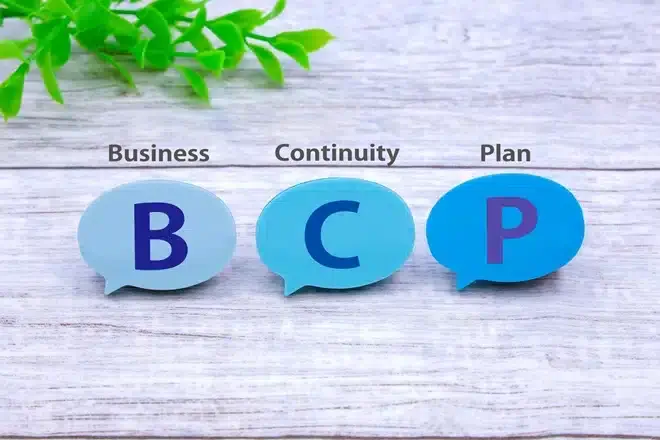Obligation to Develop BCP for Nursing Care Facilities | Explanation of Creation Methods and Benefits

BCP stands for Business Continuity Plan, which refers to a strategy designed to continue and restore business operations in the face of unforeseen circumstances such as disasters or infectious diseases. As of April 2024 (Reiwa 6), the creation of a BCP has become mandatory for nursing care facilities. However, there may be questions about how to create one, whether there are any benefits to creating a BCP, and other concerns.
In this article, we will explain the basics of BCPs for nursing care facilities, including detailed information on what should be included in the plan, its benefits, and how to create one. We will also discuss the risks of not having a BCP in place, so please use this as a reference.
What is BCP/BCM in Nursing Care Facilities?

BCP stands for Business Continuity Plan, which refers to a strategy designed to prevent interruption of critical business operations or to facilitate rapid recovery in the event of unforeseen circumstances such as natural disasters, infectious disease outbreaks, terrorist attacks, and other emergencies.
Similarly, BCM stands for Business Continuity Management, which involves the administration and management of BCP. In Japanese, it is translated as 事業継続マネジメント (Business Continuity Management).
The Cabinet Office’s Business Planning Guidelines[ja] describe BCP and BCM as follows:
A Business Continuity Plan (BCP) is a plan that outlines policies, systems, and procedures to prevent interruption of critical business operations or to restore them as quickly as possible in the event of unforeseen circumstances such as major earthquakes, the spread of infectious diseases, terrorist incidents, major accidents, disruption of supply chains, or sudden changes in the business environment.
Source: Cabinet Office Disaster Prevention Information | Business Planning Guidelines[ja]
Management activities that are carried out in normal times, such as formulating and maintaining BCPs, securing budgets and resources to achieve business continuity, implementing preventive measures, conducting education and training to promote these initiatives, inspecting, and continuously improving, are called Business Continuity Management (BCM). BCM is positioned as a strategic activity at the management level.
Creation of BCPs in Nursing Care Facilities is Mandatory

Following the revision of the nursing care remuneration in 2021 (Reiwa 3), a three-year transitional period was established, after which the creation of Business Continuity Plans (BCPs) and the execution of Business Continuity Management (BCM) in nursing care facilities became fully mandatory from April 2023 (Reiwa 6). The Ministry of Health, Labour and Welfare’s document on the “Main Points of the Nursing Care Remuneration Revision for Fiscal Year 2021 (Reiwa 3)[ja]” states the following:
In order to ensure that necessary nursing care services can continue to be provided even in the event of infectious diseases or disasters, all nursing care service providers are required to develop plans for business continuity, conduct training, and implement drills (simulations). (※A three-year transitional period is provided)
Source: Ministry of Health, Labour and Welfare | Main Points of the Nursing Care Remuneration Revision for Fiscal Year 2021 (Reiwa 3)[ja]
Risks of Failing to Create a BCP for Nursing Care Facilities

Should a nursing care facility fail to create a Business Continuity Plan (BCP), it may face the following risks:
- Subject to administrative guidance
- Potential liability for compensation
- Ineligibility for additional nursing care fees
Here, we will explain each of these risks in detail.
Subject to Administrative Guidance
If a BCP has not been established, there are currently no specific penalties announced. However, it is important to note that failure to have a BCP can lead to administrative guidance due to non-compliance with operational standards. Furthermore, if the guidance is not followed, the facility may face administrative penalties such as revocation of its designation.
Upon revocation, neither the corporation nor any other officers, including the parent company or actual controllers, can receive a new designation for at least five years. This means that they will be unable to conduct nursing care business for the same duration (Japanese Nursing Care Insurance Act, Article 70, Paragraph 2, Items 6 to 6-3).
Potential Liability for Compensation
While failure to establish a BCP does not result in fines, if an accident or damage occurs without a BCP in place, the facility may be held liable for compensation due to a breach of the duty of care.
A notable case that highlighted the duty of care towards employees and customers is the tsunami disaster involving the Hiwadayama Kindergarten bus during the Great East Japan Earthquake.
Hiwadayama Kindergarten had established a BCP, and their manual stated, “In the event of a strong earthquake with the potential for disaster, guide everyone to the north side of the schoolyard, calm them without causing panic, and watch over the children until their guardians arrive to pick them up.” However, the manual was not sufficiently disseminated, and no evacuation drills were conducted to practice the procedures.
As a result of the decision to send the children to their guardians, the school bus was engulfed by the tsunami, leading to the death of five children. The kindergarten principal and the managing corporation were both found liable for damages due to their failure to collect necessary information.
Reference: Supreme Court of Japan | Hiwadayama Kindergarten Bus Tsunami Disaster Case (Sendai District Court, September 17, 2013)[ja]
Ineligibility for Additional Nursing Care Fees
In the 2021 (Reiwa 3) nursing care fee revision, nursing care fees were increased by 0.7%. However, if the following criteria are not met, a reduction will be applied:
- Establishing a BCP for infectious diseases and natural disasters
- Taking necessary measures in accordance with the established BCP
The extent of the reduction varies by service, with “facility-based and residential services” facing a 3% reduction of the standard unit price, and “other services” facing a 1% reduction. There is a transitional measure in place, which exempts facilities from the reduction for one year until March 31, 2025 (Reiwa 7).
Essential Elements to Include in a Nursing Care Facility’s BCP

The roles required of nursing care service providers are as follows:
- Continuity of services
- Ensuring the safety of service users
- Ensuring the safety of staff
Japanese Labor Contract Law (労働契約法) Article 5
Employers shall give due consideration to ensure that workers can perform their duties while securing their life, body, and safety.
Based on the above, it is mandated that the BCP for nursing care facilities must establish response measures for both COVID-19 infections and natural disasters. Here, we will explain the details of each.
Response Methods for COVID-19
In nursing care facilities and businesses, it is required to create a Business Continuity Plan (BCP) to address COVID-19. The contents of a BCP during an infectious disease outbreak include the following:
| Normal Conditions Response | Establishing and maintaining a system, implementing measures for infection prevention, securing stockpiles such as protective gear and disinfectants, conducting training and drills, and reviewing and revising the BCP |
| Initial Response | Reporting to managers and family members, considering service provision, visiting medical institutions, etc. |
| Establishing an Infection Spread Prevention System | Coordinating with public health centers, responding to close contacts, securing staff, etc. |
It is important to note that the content of the BCP will vary depending on the type of facility, such as day service, residential, or home-visit based, as the situation and response after an infectious disease outbreak will differ. According to the Japanese Ministry of Health, Labour and Welfare’s “BCP Guidelines for Disability Welfare Service Providers during the Outbreak of COVID-19[ja]“, it is crucial to prepare for a BCP before the outbreak of an infectious disease. It is essential to develop a BCP that allows for a smooth response when an infectious disease occurs, and to regularly conduct training and drills, as well as secure stockpiles.
Response Methods to Natural Disasters
Nursing homes and business establishments must also develop a Business Continuity Plan (BCP) to respond to natural disasters such as earthquakes and floods. The contents of a BCP for natural disasters include the following:
| General Principles | Prioritizing tasks such as checking hazard maps, and conducting training and drills |
| Normal Conditions Response | Safety measures for buildings and facilities, contingency plans for when utilities such as electricity, gas, and water are cut off, and communication paralysis measures, etc. |
| Emergency Response | Designating response bases, confirming the safety of individuals, criteria for staff assembly, staff management, recovery measures, etc. |
| Collaboration with Other Facilities | Establishing a collaborative system, coordinated response |
| Collaboration with the Community | Dispatching staff in the event of a disaster, managing welfare evacuation shelters |
The BCP for natural disasters must be developed not only for normal and emergency situations but also for coordination with other facilities and the local community, making its content more extensive than that of a BCP for infectious diseases.
The Benefits of Creating a BCP for Care Facilities

Developing a Business Continuity Plan (BCP) requires time and effort. However, it is also true that creating a BCP can provide significant benefits, such as ensuring the safety of residents and staff, and qualifying for tax incentives. Here, we will explain the advantages of formulating a BCP.
Ensuring the Safety of Residents and Staff
Having established protocols for infectious disease outbreaks or natural disasters ensures that both residents and staff can respond swiftly and effectively in emergencies. While the risk of operational paralysis due to confusion in the event of an emergency exists, creating a Business Continuity Plan (BCP) allows for the prioritization of critical operations, facilitating a rapid recovery. Additionally, this preparation helps to build trust with users, their families, and the community.
Tax Incentives
Companies that incorporate measures determined by the Minister of Economy, Trade and Industry (such as establishing systems and taking preemptive actions) into their Business Continuity Plan (BCP) and receive certification for their “Business Continuity Enhancement Plan” are eligible for special depreciation of 18% on investments in disaster prevention and mitigation equipment to strengthen their measures against disasters (16% after April 1, 2022 (Reiwa 7)).
Specific examples of eligible equipment include:
- Machinery and equipment (1 million yen or more): such as in-house generators and drainage pumps
- Tools and fixtures (300,000 yen or more): such as seismic isolation racks and satellite phones
- Building-related facilities (600,000 yen or more): such as flood barriers and fire shutters
Subsidies and Financial Support
If you develop a Business Continuity Plan (BCP) and obtain certification for your Business Continuity Enhancement Plan, you will receive preferential treatment when applying for subsidies. The types of support available include the following:
| Financial Support | Credit Guarantee | Additional separate guarantee limits for credit insurance for businesses certified with a Business Continuity Enhancement Plan |
| BCP Funds | For those installing disaster prevention equipment based on BCPs or those who have received certification, a reduction of 0.9% from the standard interest rate (up to 400 million yen) Details: Japan Finance Corporation | BCP Funds[ja] | |
| Subsidies | Manufacturing Subsidies | If certified with a Business Continuity Enhancement Plan, you will receive additional points during the review process for manufacturing subsidies. Official website for manufacturing subsidy projects: Comprehensive Manufacturing Subsidy Site[ja] |
| BCP Implementation Promotion Subsidy (Tokyo Metropolitan Government) | Part of the expenses required for the introduction of goods and equipment necessary for BCP implementation is subsidized. Details: Tokyo Metropolitan Small and Medium Enterprise Support Corporation | BCP Implementation Promotion Subsidy[ja] |
The content of BCP-related subsidies varies by municipality. Additionally, some private financial institutions offer lending programs specifically for companies that have created a BCP. If you are developing a BCP, it is advisable to inquire with the local government of your facility’s location or with financial institutions you have dealings with.
Priority Vaccination
Under Article 28 of the Japanese Act on Special Measures for Pandemic Influenza and New Infectious Diseases Preparedness and Response (2009), registered businesses with a formulated Business Continuity Plan (BCP) during an infectious disease outbreak are eligible to administer priority vaccinations. Priority vaccination refers to the preemptive immunization of employees and other related personnel of registered businesses.
To become a registered business eligible for priority vaccination, it is necessary to submit a registration application to the government in advance.
How to Create a BCP for Nursing Care Facilities

Some may not know how to go about creating a Business Continuity Plan (BCP). Here, we will explain the method for developing a BCP for nursing care facilities.
Establish a Committee for BCP Development
To begin working on the BCP, first establish a committee. The development committee should include managers and responsible parties from each location and service, as well as individuals who can gather input from the field. Once the committee is formed, assess the current state of the nursing care facility and identify any issues.
Utilizing Guidelines and Templates
The Ministry of Health, Labour and Welfare provides guidelines and templates for creating BCPs. If you are unsure where to start or how to proceed, you can create a BCP by following the Ministry’s guidelines and using the provided templates.
Templates are available for different types of facilities, such as day services and residential care, so you should create your BCP according to the template that matches the service you provide.
Guidelines and templates can be found on the following website, so please use them as a reference.
Ministry of Health, Labour and Welfare | Training on Support for Creating Business Continuity Plans (BCP) in Nursing Care Facilities and Businesses[ja]
Summary: Immediate Response Required for the Mandatory Creation of BCPs in Nursing Care Facilities

As of April 2024 (Reiwa 6), the creation of Business Continuity Plans (BCPs) has become mandatory for nursing care facilities. For these facilities, developing a BCP is crucial to ensure smooth operations during the spread of infectious diseases or natural disasters, and to facilitate rapid recovery. Additionally, there are benefits such as tax incentives, subsidies, and financial support, as well as priority vaccination. To be prepared for emergencies that could arise at any time, it is essential to create a BCP.
If you are struggling with creating a BCP or unsure how to proceed, it is advisable to consult with a lawyer.
Monolith Law Office is a law firm with extensive experience in both IT and legal matters, particularly in internet law. If you have any concerns regarding BCPs, please feel free to contact us for a consultation.
Guidance on Measures by Our Firm
The caregiving industry is governed by a complex web of laws, including the Japanese Long-Term Care Insurance Act, the Japanese Elderly Welfare Act, and the Japanese Companies Act. Monolith Law Office serves as legal counsel for the General Incorporated Association National Federation of Caregiver Corporations and for caregiving service providers across all prefectures nationwide, possessing extensive know-how in laws related to the caregiving business.
Areas of practice at Monolith Law Office: Corporate Legal Affairs for IT & Startups[ja]
Category: General Corporate
Tag: General CorporateIPO





















